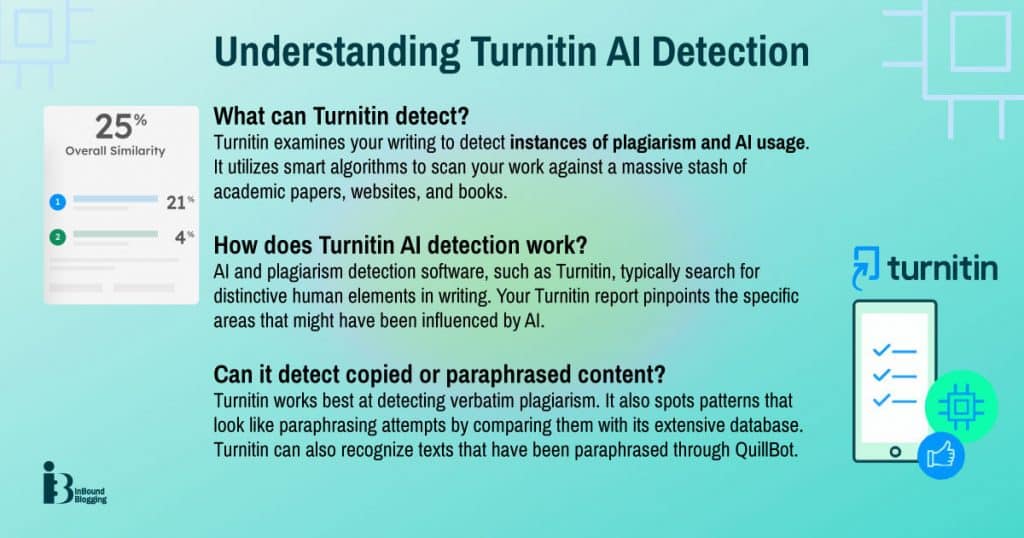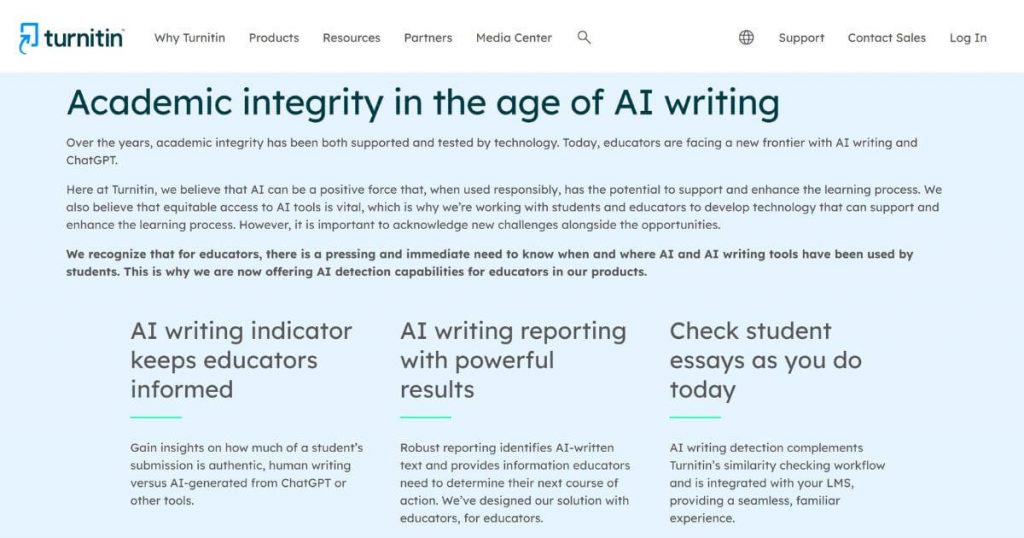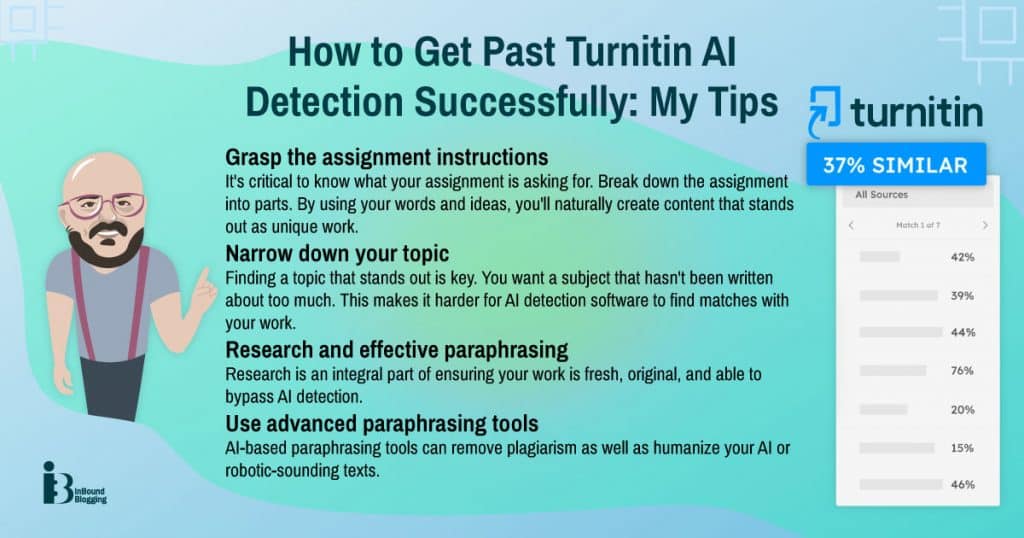Ever faced that heart-racing moment when you submitted a paper, silently praying it wouldn’t be flagged by Turnitin’s clever artificial intelligence (AI)? You’re not alone. In fact, with over 50 million students relying on Turnitin globally, the struggle is real.
Through my exploration into outsmarting AI content detection, I’ve gathered some invaluable tips to ensure your work remains authentically yours. I won’t teach you how to trick Turnitin but how to revolutionize the way you navigate Turnitin’s watchful algorithm, all while upholding the highest standards of academic integrity.
Buckle up because we’re about to dive in deep.
How to Avoid Turnitin AI Detection [Key Takeaways]
- Turnitin compares your writing to a massive database and flags too many similarities as possible plagiarism. Keeping the similarity score low is essential. Usually, anything over 25% could raise concerns.
- Plagiarism can result in severe outcomes for both students and professionals, including unsuccessful assignments, damaged reputations, or even expulsion from educational or professional institutions.
- Use original research and effective paraphrasing when writing papers. This makes it hard for Turnitin to find matches with previously published work.
- Writing by hand, without help from AI tools, ensures that the work reflects your personal effort and creativity.
- If you want to bypass Turnitin, make sure it’s for the right reasons, or, in other words, to keep the process ethical and protect yourself and your work from possible negative accusations.
Understanding Turnitin AI Detection

As an AI fan, I’m always intrigued by the sophistication of tools like Turnitin that use artificial intelligence to sniff out unoriginal content. It’s a fascinating dance between technology and text.
Delving into how this digital gatekeeper works gives us insights into the frontier of academic integrity in our tech-driven world.
What can Turnitin detect?
Turnitin examines your writing to detect instances of plagiarism and AI usage. It utilizes smart algorithms to scan your work against a massive stash of academic papers, websites, and books. The system is on the lookout for any parts that seem a bit too close to what’s already out there.
This detection system helps teachers spot when students copy or use someone else’s ideas without giving credit where it’s due. It scans every paper and gives it a similarity score. A high score means there is likely copied content, while a low score suggests the work is original.
To pass Turnitin’s AI detection, you have to write in your own words and cite the resources you’ve used. It can catch you if you try to trick it with synonyms or mixed-up sentences from someone else’s text. Always aim for uniqueness in your assignments to avoid problems with Turnitin.
How does Turnitin AI detection work?

Keep in mind that AI and plagiarism detection software, such as Turnitin, typically search for distinctive human elements in writing that aren’t easily mimicked by machines alone. Your Turnitin report also pinpoints the specific areas that might have been influenced by AI.
This helps teachers catch instances where students might have used generative AI in their work. Basically, it helps keep things fair and makes sure students are doing their own work.
Can it detect copied or paraphrased content?
Turnitin has a keen eye for copy-and-paste jobs. In fact, it works best at detecting verbatim plagiarism. Be careful not to lift lines directly from sources without citing them. That’s a surefire way to get flagged.
Paraphrasing needs skill, too. Simply changing a few words here and there won’t trick the system. Turnitin spots patterns that look like paraphrasing attempts by comparing them with its extensive database.
It’s worth noting that Turnitin can now recognize texts that have been paraphrased through QuillBot.
Why Bypass Turnitin Plagiarism and AI Detection?
I’ve often wondered if there’s a legit reason to try and sidestep Turnitin. After all, we’re talking about ensuring our work is genuinely ours. It’s not just about steering clear of the obvious no-no that is plagiarism—it’s about owning the creativity and effort you put into your work while also appreciating the serious repercussions that lifting content can have on both academic paths and professional roads ahead.
Consequences of plagiarism on academic and professional careers
Plagiarism can ruin academic careers. If teachers catch you cheating, they might give you a zero on the assignment or fail you in the course. Some schools could even kick students out for copying others’ work. This makes it hard to get into good colleges or land scholarships.
In professional life, stealing someone else’s words damages your reputation. You could lose your job and find it tough to get hired again in your field. People respect original ideas, not copied ones.
Is it legal to use AI writing tools?
Absolutely, using AI tools is legal. You can use ChatGPT or any other advanced AI tool to help with your writing tasks. These tools work by understanding your prompt input and then creating text that fits your needs. They’re fantastic for brainstorming ideas or getting a first draft down quickly.
However, I always make sure my final work is truly mine. Relying solely on the power of AI might get tricky if you want to pass Turnitin’s careful eyes. Some schools and companies have rules about how much AI-generated content you can submit.
So, it’s smart to check what those rules are wherever you plan to turn in your work.
As an AI enthusiast myself, I believe in blending my own creativity with the capabilities of these tools. This way, I maintain originality while enhancing productivity.
How to Get Past Turnitin AI Detection Successfully: My Tips

I’m going to let you in on some insider advice for outwitting Turnitin because originality is more than a buzzword—it’s your academic fingerprint. However, it’s not about how to fool Turnitin. Instead of seeking shortcuts that compromise integrity, I’ll show you tactics to strengthen and showcase your authentic voice.
Here are my tips on how to pass Turnitin AI detection and how to avoid unjustified accusations of plagiarism:
Grasp the assignment instructions
Before trying to bypass Turnitin detection, it’s critical to know what your assignment is asking for. This means reading the instructions carefully. Teachers often look for specific things in your work. If you miss these points, even a paper that gets past Turnitin might still get a bad grade.
To make sure everything is original, break down the assignment into parts. Look at each section and ask yourself how you can show your own thinking. This way, by using your words and ideas, you’ll naturally create content that doesn’t just avoid detection but also stands out as unique work.
Narrow down your topic
This one is among the most efficient tips to pass Turnitin AI detection and avoid plagiarism.
Finding a topic that stands out is key. You want a subject that hasn’t been written about too much. This makes it harder for AI detection software to find matches with your work.
Try digging deep into less explored areas of your interest or combining different ideas in new ways.
Research is important, but so is putting your own spin on things. Use what you’ve learned and think outside the box. Show Turnitin something fresh, with unique angles and personal insights in your writing. That way, even when Turnitin compares text, yours won’t just blend in with the crowd.
It’s smart to stay ahead of plagiarism issues by choosing an intriguing question or problem no one else has tackled yet. Your original approach will reflect in the content, making it undetectable by Turnitin AI and plagiarism detection tools.
Research and effective paraphrasing
I always hit the books before I start writing. Doing diligent research is an integral part of ensuring my work is fresh, original, and able to bypass AI detection. The more I read, the more my imagination is stimulated. This helps me come up with unique ideas that Turnitin hasn’t seen a million times.
Here is a clever tip from Campbell Tourgis, Executive VP and Chief Operating Officer at Wainbee:
“Make sure your AI-generated content sounds human when read aloud to avoid detection by Turnitin. Listen for awkward phrasing, repeated words, or sentences that sound off, and revise them. Mimic the natural flow of human language and avoid robotic or formulaic patterns.”
Paraphrasing comes next, and it’s like putting a puzzle together in my own way. I read a sentence, break it down, then rebuild it with new words and my own twist. It’s more than swapping words. It’s about understanding the idea fully and explaining it like I’m telling a friend.
This makes my writing sound human and ultimately helps me pass Turnitin AI detection.
“There’s no other ethical way to bypass Turnitin’s AI detection other than to rewrite the content in your own words. You can do this by expounding on some points, adding personal experiences or anecdotes, and integrating more references from reliable sources. It’s the only way to add human complexity to your content. At the end of the day, it’s important to use AI tools ethically, especially when it comes to business and academic purposes.” — Baidhurya Mani, Founder, Sell Courses Online
Use advanced paraphrasing tools
Sometimes time presses us, and it is normal to seek help from a friend, be it a human or an AI tool. In this high-tech era in which we live, many AI-based paraphrasing tools can remove plagiarism as well as humanize your AI or robotic-sounding texts.
“I believe the most effective way to generate high-quality, original content that can bypass plagiarism detection is through advanced techniques like paraphrasing, summarization, and seamless synthesis. Simply trying to ‘outsmart’ these tools often results in lower quality writing.” — Adil Advani, Associate Product Owner, Securiti.ai
I’ve tried quite a few rewriting tools myself, but two of them stand out: Undetectable AI and WordAi.
Undetectable AI:
- AI-driven undetectability: True to its name, Undetectable AI is designed to create content that is less likely to be flagged by plagiarism checkers and AI detection tools, making it a valuable assistant for those concerned about originality.
- Diverse writing styles: The tool offers the ability to mimic various writing styles, allowing users to adapt the output to specific contexts or preferences.
- User verification: Undetectable AI employs user-friendly verification processes, ensuring that the generated content aligns with the user’s intentions and requirements.
WordAi:
- Rewriting sentences like a pro: WordAi understands what each sentence is about and spins it from scratch, keeping things original while making sure it still makes sense.
- Spicing things up: WordAi jazzes up the text game by spotting and throwing in some Latent Semantic Indexing (LSI) keywords. This not only makes each rewrite more one-of-a-kind but also gives it a boost for ruling the search engine rankings.
- Talking like a human, not a robot: WordAi generates alternative expressions for the same ideas, preventing duplicate content and providing a human-like, realistic tone to the rewritten text.
Each of these rewriting tools brings something distinctive to the table, catering to different needs and preferences in the content creation process.
Taylor Scher, an SEO Consultant at TaylorScherSEO advises using three different AI tools to remove AI writing patterns:
“While AI detection tools aren’t entirely accurate, especially for SEO, I find the best way to make AI more realistic is to run it through multiple AI tools. My route usually goes from ChatGPT to Claude to Semrush’s article rewriter. This process typically removes most of the robotic text and results in a more human-like output. Usually, you’ll need to edit it further to really pack as much value as possible, but those three tools are often necessary to get the job done.”
Write without help
I love writing my own thoughts and ideas by hand. It’s a wonderful way to bypass Turnitin AI detection. This means I put words down on paper myself, without any help from AI writing tools like ChatGPT.
This shows that the work is mine alone. Writing by hand forces me to think more about each word I use. My brain works harder, and this helps create original content that can pass AI detection with ease. Plus, it feels good to see a page filled with my own handwriting—it’s clear proof of my effort.
To bypass AI detection and not raise red flags on plagiarism, I always ensure I start fresh when tackling an assignment. No copy-pasting from sources or relying on AI-written content. Using simple language and short sentences keeps my style unique.
This way, even advanced AI content detectors like Turnitin see my work as one-of-a-kind.
Conclusion
If you are asking, “How to beat Turnitin?”, the answer is simple: get creative! Dive deep into your subject and employ your writing skills, making sure you write every word yourself. Remember, tools like Turnitin are smart, but they can’t outthink original thought.
Keep it real, keep it you, and success will follow. Stay unique and let your authenticity shine through in every paragraph.
Eager to learn more about outsmarting AI detectors? Explore my blog post on bypassing GPTZero detection.
FAQ
What does Turnitin check for?
Turnitin checks for similarities between submitted papers and its extensive database. It aims to identify instances of plagiarism, improper citations, and similarities with previously submitted works. Moreover, Turnitin can spot AI-generated content easily.
How does Turnitin detect AI?
Turnitin detects AI by using algorithms that analyze the given text and identify patterns that indicate potential AI-generated content. It has an AI writing detection indicator that shows the percentage of text that is likely generated by AI. This helps educators identify when AI writing tools have been used in students’ papers.
What AI detector does Turnitin use?
The AI detection model used by Turnitin is based on an open-source foundation model developed by Huggingface. Turnitin’s AI checker has been trained, evaluated, and fine-tuned multiple times.
Can I use Undetectable.ai to bypass Turnitin?
Undetectable AI aims to help get around Turnitin by making your work look original, but this does not guarantee results. You should always use caution when using it, and make sure to properly cite any sources that you use.
How can I pass the Turnitin check without getting detected by its system?
The best way to avoid AI detection by Turnitin is to follow a complex strategy: pick an unusual topic, research it deeply, paraphrase your findings, cite your sources, and try writing by hand. However, these methods are not foolproof. So, if you are wondering how to get around Turnitin or how to get a low Turnitin score, you should refrain from using AI’s help and use proper citations to avoid plagiarism issues.
If my work was written with AI’s help, would it be easy for Turnitin to detect it?
Relying on AI heavily, letting it write instead of you, and not making any changes to the output is a major mistake. Instead, AI should be used for idea generation and inspiration. Alternatively, there’s a significant likelihood that you won’t bypass Turnitin AI detection.
What similarity score is acceptable on Turnitin?
Well, there’s not a single percentage set in stone. Schools and universities often decide on their own what they consider to be too high. Generally, anything above a 25% similarity score might catch an instructor’s attention.



